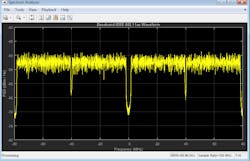This file type includes high resolution graphics and schematics when applicable.
Wireless local area networks (WLANs) have become so commonplace—and so taken for granted—that most users forget how dependent they have become on gaining quick and convenient access to the Internet by means of them. In fact, WLANs have become such a part of modern life that larger commercial businesses often provide free access to their WLANs as a convenience for customers.
Nevertheless, designing a WLAN device can be a challenge. Luckily for those tasked with designing WLANs, there’s now a software specifically intended to ease their way: the WLAN System Toolbox from MathWorks. The system toolbox builds upon the firm’s popular mathematics-based MATLAB software, providing models and design guidance that help engineers develop and integrate WLAN devices.
Building a WLAN transmitter or receiver requires successful coordination of hardware and software. Aside from achieving required performance levels from transmitters, receivers, and heir antennas and component parts, specific waveforms must be generated and maintained to provide optimum WLAN performance—as well as to minimize interference with other wireless devices and services in the vicinity.
The WLAN System Toolbox is extremely focused on WLAN design and development. It provides the necessary system functions to mathematically analyze modulation, transmission, reception, and demodulation of advanced high-frequency waveforms—notably, configurable physical layer waveforms for the IEEE 802.11ac and IEEE 802.11b/a/g/n WLAN standards. The WLAN System Toolbox includes reference designs to enable users to model the transmission and reception of WLAN signals while accounting for different impairment and interference effects. This leads to a better understanding of how different conditions and operating environments can affect performance.
According to MathWorks’ senior strategist for signal processing applications, Ken Karnofsky, “WLAN System Toolbox enables designers to focus on designing unique IP, instead of spending time creating reference models and generating test signals.” Karnofsky notes that the company’s LTE System Toolbox was well received in the marketplace, spurring the creation of a similar software-based solution for WLAN developers: “WLAN System Toolbox delivers these capabilities for WLAN system designers and test engineers.”
The WLAN System Toolbox provides MATLAB source code for the creation of different waveforms, component models, and analysis procedures. The design tool offers physical layer (PHY) waveforms for IEEE 802.11ac and IEEE 802.11b/a/g/n WLAN standards . Also offered are variety of modeling functions for WLAN transmitters and receivers, including for single-input, single-output (SISO) and multiple-input, multiple-output (MIMO) configurations.
The toolbox can be used to generate very-high-throughput (VHT), high-throughput (HT), and legacy, non-HT signals with channel coding and an assortment of modulation techniques. These include orthogonal-frequency-division-multiplex (OFDM) and direct-sequence-spread-spectrum (DSSS) modulation.
The design examples and standards-compliant waveforms contained within the WLAN System Toolbox can be used to assist real-world testing of WLANs, providing references for signal generation and analysis measurement equipment. Different functions and system objects can show examples of constellation diagrams for input signals; a frequency spectrum of time-domain signals; and even WLAN waveforms that can be used as starting points for an arbitrary waveform generator or other test signal generator to create stimulus signals for WLAN system testing. Measurement examples in the WLAN System Toolbox handle readings of error vector magnitude (EVM) and computing the bit error rate (BER) or symbol error rate SER) of data carried on a WLAN input signal.
As with many of the firm’s software tools, a free trial version of the WLAN System Toolbox is available for potential users to determine if this software package meets their requirements. More details are available by visiting the MathWorks’ website.
MathWorks, 3 Apple Hill Dr., Natick, MA 01760-2098; (508) 647-7000
This file type includes high resolution graphics and schematics when applicable.
About the Author
Jack Browne
Technical Contributor
Jack Browne, Technical Contributor, has worked in technical publishing for over 30 years. He managed the content and production of three technical journals while at the American Institute of Physics, including Medical Physics and the Journal of Vacuum Science & Technology. He has been a Publisher and Editor for Penton Media, started the firm’s Wireless Symposium & Exhibition trade show in 1993, and currently serves as Technical Contributor for that company's Microwaves & RF magazine. Browne, who holds a BS in Mathematics from City College of New York and BA degrees in English and Philosophy from Fordham University, is a member of the IEEE.


